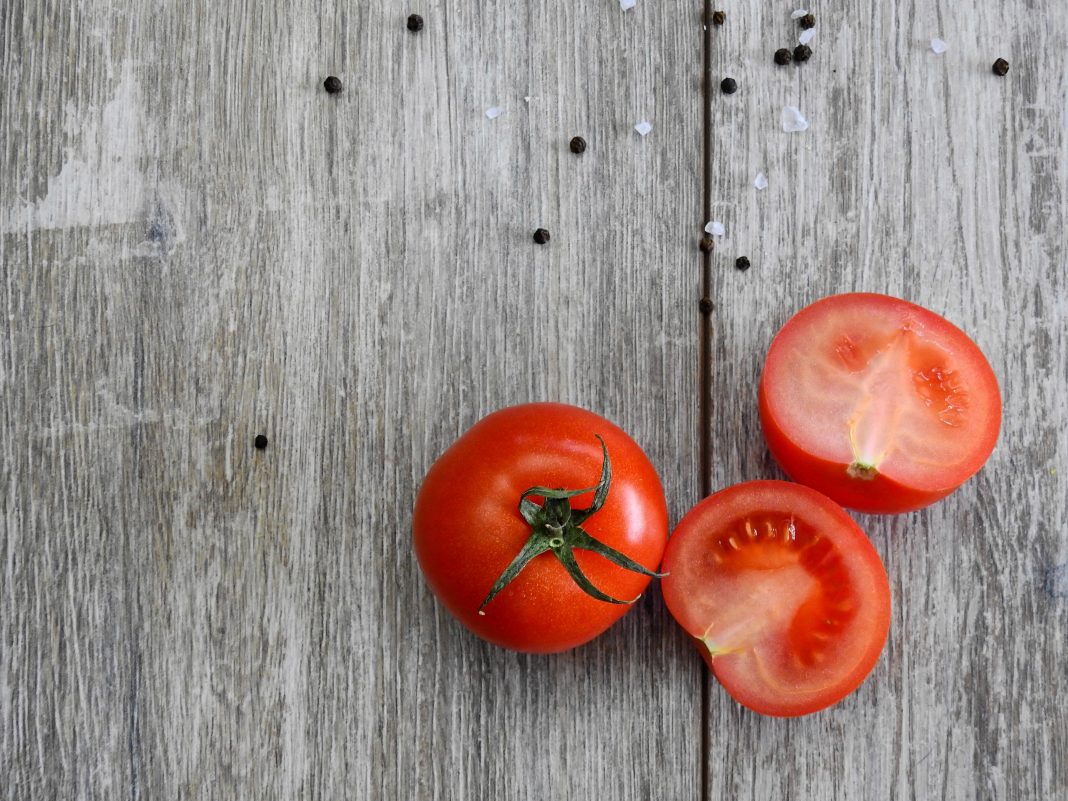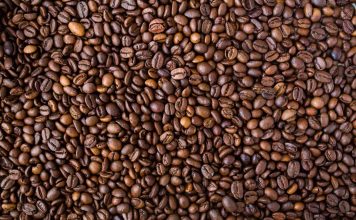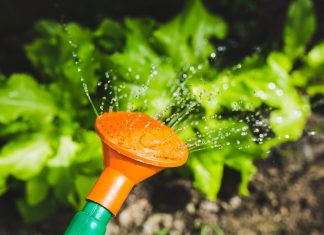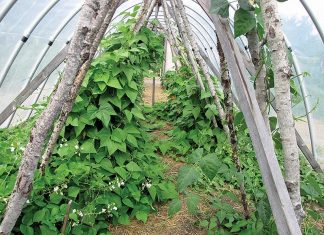By Jackie Clay-Atkinson
Nearly all of us homesteaders grow tomatoes in our gardens. Tomatoes are hugely valuable as a homestead crop. After all, they give us a wide variety of products.
Many people just run to their local big box store and buy seeds or tomato plants as spring hits full force. But homesteaders are self-reliant; with tomatoes, this means not only starting your own plants to set out in your garden but also planting tomatoes from which you can save your own seeds, bringing things full circle.
Heirloom tomatoes have been around for generations, produce well, and taste great. The term “heirloom” means a crop which has been passed down through generations for 50 years or more. We grow more than 30 different heirloom tomatoes and all have different tastes, looks, and uses. They come in all colors of the rainbow — white, red and gold striped, red with blue shoulders, nearly black, and variations of all these colors.
Open-pollinated tomatoes mean that the “mother” plant produces seeds that, when planted, will produce tomatoes exactly like the mother plant. This is opposed to hybrid tomatoes, which are two varieties of tomato crossed to produce a desired offspring. Hybrid tomatoes are not GMOs (genetically modified organisms). These tomatoes will produce seeds and the seeds will produce tomatoes. But you never know what characteristics these tomatoes will have due to their varied parentage.
With open-pollinated tomatoes, you always get the same results. But open-pollinated does not necessarily mean old or heirloom. There are many plant breeders who are striving to create new open-pollinated tomatoes. Some are scientists, some are dedicated tomato breeders, and others are simply dedicated home gardeners who have created their own open-pollinated tomatoes by crossing, then stabilizing the resultant tomatoes so that they breed true.
While shopping for tomato seeds, pick ones suited to your needs and likes that will ripen in your climate. Here in Northern Minnesota, we find it’s best to grow tomatoes which will ripen within 90 days, as we run into possible early fall frosts.
We plant mostly indeterminate varieties. Indeterminate tomatoes grow tall and vining and to get the best crop possible, we stake the plants up with 6½-foot steel fence T-posts and grow them in homebuilt cages made of concrete reinforcing wire. Indeterminates will keep growing, blooming, and setting new tomatoes until frost kills the plant.
Determinates, on the other hand, are shorter and usually have a very stout main stem. They bear in a big flush of fruit, then stop as the plant is finished. Some determinates are very small, fitting easily into a six-inch pot or hanging basket. Mom used to keep some plants on the windowsill in her kitchen to grow fresh tomatoes year-round. Those small cherry tomatoes sure tasted great on salads in February!
Let’s take a look at just some of the open-pollinated tomato varieties which are available for gardeners today, along with some of the best uses for them. Bear in mind, this is just a tiny sampling so you can get a good idea of the wide variety out there.
Beefsteak-type tomatoes
Bill Bean
Our favorite beefsteak tomato is one from Italy, given to us by Bill Bean, the local Veteran Service Officer. This old heirloom tomato is an exceptionally early beefsteak. It has a very strong stem, requiring tomatoes to be cut from the vine. It matures in about 65-70 days and produces a huge crop of red fruit weighing well over a pound; some up to more than four pounds. Our largest fruit last summer measured 22 inches around! Bill Bean is a meaty, relatively seedless, not too juicy tomato — making it perfect for sandwiches as it does not make the bread soggy. It’s hugely productive; Will counted 12 ripe tomatoes on one vine well over two pounds, along with 20 others in various stages of ripeness. It has an exceptional old-fashioned tomato taste that is nicely balanced between sweet and tart. Bill Bean is an indeterminate that grows to about five feet in height.
Brandywine
This 90-day heirloom tomato is said to be the king of beefsteak tomatoes. Grown in Amish communities back in 1885, these big, red tomatoes have a smooth, rich flavor often said to be the best. They have mildly ribbed shoulders and often grow to weigh a pound and a half. The flesh is firm, yet juicy, with just the right tang. Brandywine is a vigorous indeterminate usually reaching six feet in height.
Cherokee Purple
This heirloom Tennessee beefsteak tomato from the Cherokees is a gorgeous color; red-brown with purple shoulders. Weighing about a pound, it has a wonderful sweet, tangy, rich flavor. Some say it tastes better than Brandywine. It starts ripening in about 80 days and will really produce tomatoes for your late summer salads and sandwiches. The flesh is relatively soft and the skin tender, making it great for garden snackers. It’s one of our favorites, growing on an indeterminate vine reaching seven feet in height.
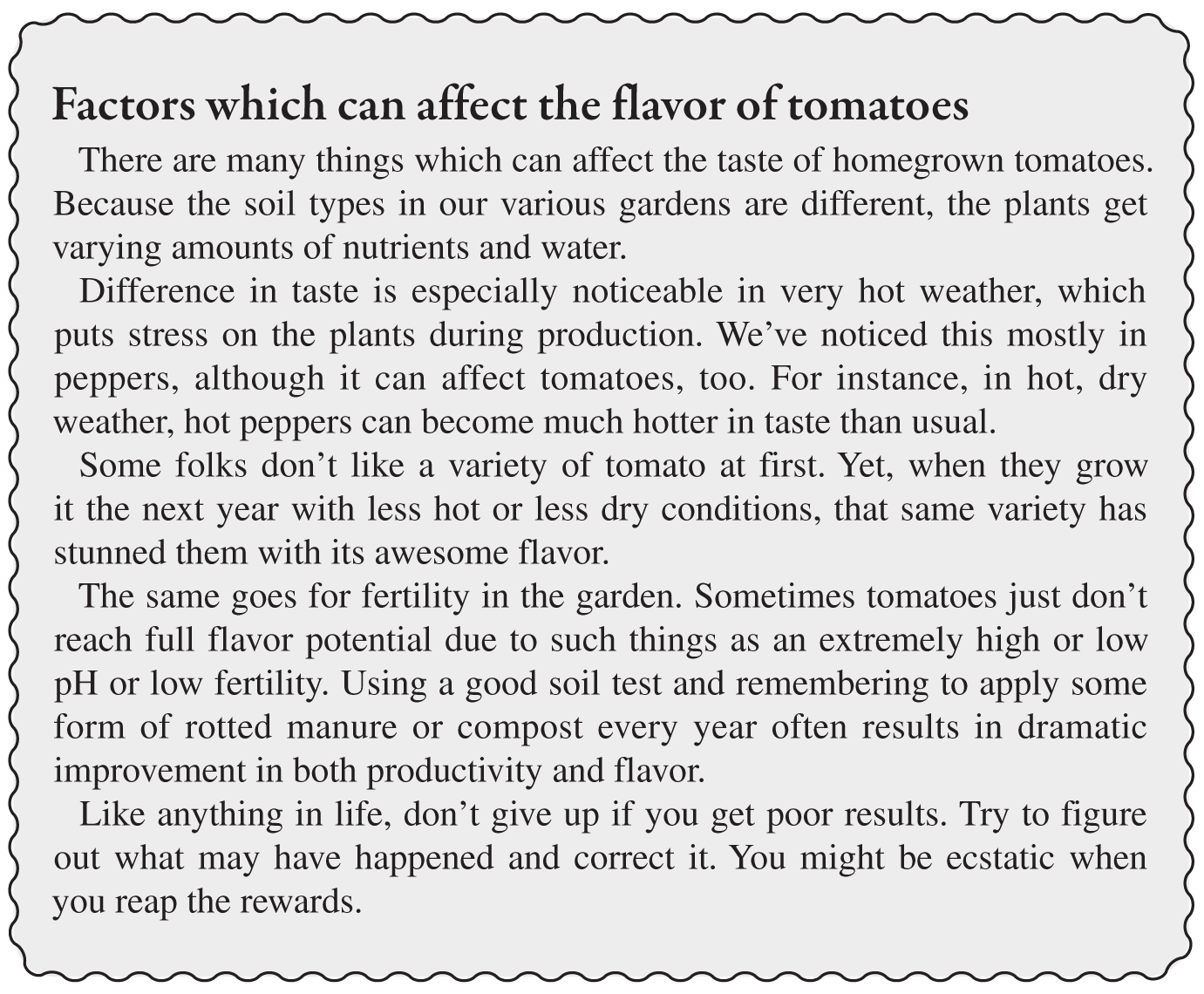
Mid-size tomatoes
Amish Gold Slicer
Everyone is drawn to this round, smooth, golden tomato in our garden. These tomatoes weigh about a pound and the plants are hugely productive. The fruit has a smooth, mellow taste; I make multi-colored salsas and salads with them. They are firm with a tender skin. You’ll harvest these gems in about 75 days from indeterminate vines about six feet tall.
Berkeley Pink Tie Dye
These beautiful tomatoes have a bronze-green base and iridescent red stripes shooting upward. The flavor is excellent with that old-timey tomato taste. Berkley Pink Tie Dye weighs in at about a pound. We love them for salads and sandwiches. These rounded tomatoes ripen in about 80 days from six-foot-tall indeterminate vines.
Blue Beauty (Indigo Blue Beauty)
Blue Beauty is one of my very favorite tomatoes. The bottom is a glowing orange-red and the shoulders darken to a beautiful eggplant-purple. The flesh is dark red and full of sweet, fruity flavor that is indescribable. I use them for everything except sauce: slicing, eating fresh, salads, salsa, and canning. They begin ripening in 75 days and are hugely productive right up until frost on their indeterminate vines reaching about six feet in height.
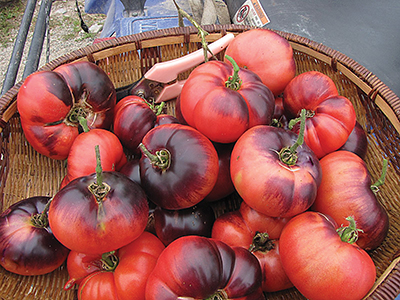
Oregon Spring
I’ve grown Oregon Spring everywhere I’ve homesteaded — Minnesota, Montana, and New Mexico, always with good results. That’s why it became our old standby. This determinate vine pops out plenty of red, nicely rounded, 10-ounce tomatoes very early. You can count on having tomatoes in 60 days from transplanting. The vines don’t have a main, central stem, but make kind of a “nest” in which dozens of tomatoes are produced. We stake and cage these determinates so they don’t lay on the ground where they are vulnerable to insects and rot. Not only do we eat them fresh, but they make a good canning tomato for every use except sauces.
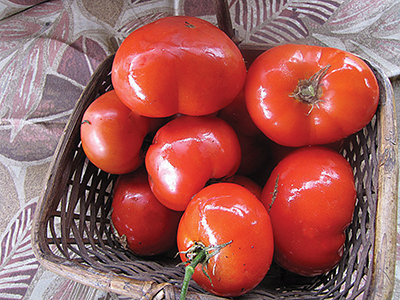
Salad or plum tomatoes
Salad or plum tomatoes are naturally smaller. We call them two- or three-bite tomatoes, depending on how many bites it takes to eat them. You’ll find them in all colors of the rainbow as well as striped.
Arctic Blum
This three-bite red, round tomato attracted a lot of culinary attention in our garden this past summer. Although not extremely juicy, these small tomatoes have a unique sweet, tart, and fruity taste. We used them on salads and on homemade pizzas. Maturing early, in 75 days, this indeterminate vine grows about five feet tall and is hugely productive.
Farthest North
We were stunned by this prolific red two-bite salad tomato. I use them for salads, sliced on pizzas, and can them whole or use them for sauce. The fruit is totally without blemish and smoothly round — so easy to work with! Farthest North will begin ripening in 55 days and keep producing until it freezes.
Jaune Flamme
We love the unique flavor of Sungold Select cherry tomatoes and found the same taste in Jaune Flamme, which is about twice the size. So there is more to love in every tomato. I use lots in multi-colored salsas and add many to my tomato sauces. This year, I plan on making golden catsup using these tomatoes. Dehydrated Jaune Flamme tomato halves are so sweet that they taste like dried apricots. This round, golden tomato, growing on five-foot indeterminate vines is just loaded with fruit from mid summer through late fall when frosts finally claim the vines.
Moravsky Div
It takes an outstanding tomato to challenge Will’s favorite Punta Banda, but Moravsky Div is doing just that. This plum tomato is productive, early (55 days or less), and has wonderful flavor inside a bright red thin skin. The tomatoes are thick-walled, making them great for saucing, salads, or even eating fresh in the garden. They grow thickly on indeterminate six-foot vines.
Cherry tomatoes
We love our cherry tomatoes. Forget the hybrids and indulge yourself in pure pleasure with these open-pollinated varieties.
Barry’s Crazy Cherry
This yellow cherry tomato is crazy. I’ve never seen so many blooms on a tomato plant in my life. The five-foot vines simply glow yellow with blooms. Those blooms soon turn into glowing, yellow, grape-like tomatoes. The skin is crisp and the flavor can easily be compared to sweet table grapes. I put lots in my salads — even fruit salads. They mature in about 75 days.
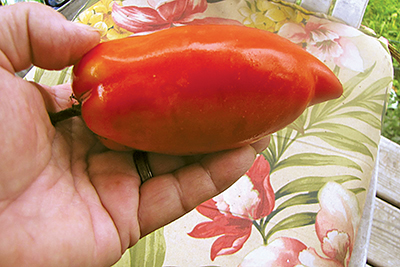
Brad’s Atomic Grape
This new cherry tomato was developed by famed tomato breeder Brad Gates. This shining, juicy fruit is encased in a tender, multicolored skin of blue, lavender, purple, orange, and yellow. It is crack-resistant and hangs well on the vine. The fleshy interior is greenish-yellow and is wonderfully fruity and sweet. It ripens in about 70 days on an indeterminate vine.
Punta Banda
I can’t write about tomatoes without mentioning my husband, Will’s, favorite — a wild Mexican tomato, Punta Banda. If you don’t have much room in your garden, consider this well-mannered determinate. It grows only about three feet tall and can even be planted in a 10-inch pot on the patio. While a bit thick-skinned and not as flavorful as some, we crank out tons of thick tomato sauce from these every year. Dehydrating intensifies the flavor; you’ll love them on a pizza or eaten out of hand as a snack.
Punta Banda also seems to have great disease resistance. Several of our customers from our Seed Treasures seed business have written to say that even when their other tomatoes had succumbed to disease, Punta Banda was still alive and putting out tomatoes.
Sungold Select
We’ve always grown the hybrid, Sungold, in our garden. But years ago, we made the decision to only grow open-pollinated varieties to further our self-reliance. Then a breeder de-hybridized Sungold and made our day. You’ll find the gorgeous, glowing yellow-orange, one-bite fruits still have that wonderful, fruity, sweet taste of their ancestors. We graze on them every day during the late summer. This indeterminate vine produces very well, beginning about 65 days from transplanting.
Paste tomatoes
On our homestead, the paste tomato reigns queen of the garden. Because they are very meaty, they are extremely quick and easy to turn into thick tomato sauce, the base of dozens of my recipes. And, being less juicy than other tomatoes, I can easily chop them for a thick, non-runny salsa.
Ernie’s Nose
This is a stunning and interesting red paste tomato given to us by our friends in southern California. The elongated, sausage-shaped tomatoes are larger than a Roma and have a Roman nose on the blossom end. We find the flavor makes very nice sauces and salsas. This tomato begins bearing at 75 days on indeterminate vines about five feet tall and the harvest is huge.
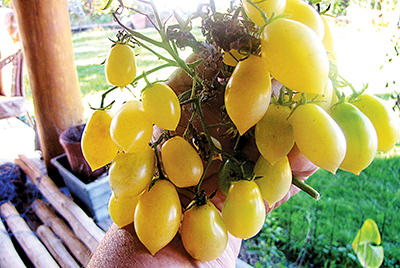
Enormous Plum
This red, fist-sized tomato often reaches a pound. It is a bit late at 85 days to maturity, but we always harvest baskets of big, fat paste tomatoes from it. I use lots in my salsa as it’s a lot easier to peel large tomatoes than smaller ones, making the work go much faster. We love the sweet flavor of Enormous Plum; it also makes excellent sauces and can even be sliced to eat on sandwiches, it’s so good. This tomato grows on an indeterminate vine.
Japanese Black Trifele (Truffle)
This Russian heirloom tomato has an unusual shape and color, looking for all the world like a fat pear with an orange-red bottom bleeding upward to a smoky purple. And when you cut the tomato in half, the flesh looks just like a big fat plum. I love making a dark, luscious sauce from these tomatoes or slicing them for a salad. Japanese Black Trifele vines are indeterminate, grow to five feet, and begin bearing in about 75 days.
Speckled Roman
The flavor of the Speckled Roman tomatoes topped our taste test in the garden last year! The color is simply gorgeous — red with brilliant yellow stripes. Shaped like an elongated Roma, the tomatoes are productive and start producing early enough at 80 days so you can harvest tons.
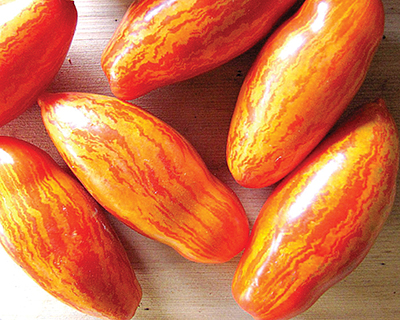
Disease-resistant varieties
Some of you live in areas where tomato diseases flourish. While not disease-proof, these open-pollinated varieties will be resistant enough to at least let you improve upon your harvest.
Legend
This big red, glossy tomato was developed by Oregon State University for resistance to late blight, making growing great tomatoes possible even in problem areas such as the Pacific Northwest or New England. Legend is an early tomato with a 68-day maturity, and it is a determinate plant so you can grow in spots where you have limited gardening possibilities.
Peron (Peron Sprayless)
Although the name Peron Sprayless makes this tomato sound like it must be genetically modified, it is not. It was naturally-bred in the early 1950s in Argentina. Peron is a round, larger tomato with great productivity. While we don’t struggle with fungal disease on our homestead in Northern Minnesota, we did love the flavor and productivity along with Peron’s beautiful round, red appearance. It matures in about 75 days on indeterminate vines.
Save your own tomato seeds
One of the benefits of growing open-pollinated tomatoes is saving your own seeds. Never again will you have to buy them from the store or seed catalogs. (After all, this is what our ancestors did.)
Tomatoes are among the easiest of crops from which to save seeds. For the most part, tomatoes are self-pollinating, having both male and female parts in the same flower. They are seldom insect-pollinated. So if you plant your plants six or eight feet apart, their tomatoes will produce pure seed.
To save your seeds, choose the best fruits from your plants and let them fully ripen on the vine. Harvest them, carefully labeling the container.
Cut the tomato in half and use your thumb to shove out the seeds and gel into a cup or bowl. Repeat until you have as many seeds as you wish to save.
Pour about twice as much warm water into the cup as you have seeds and pulp. Again, label the variety and set the container on a counter or table in a warm location for three days.
By this time, the seed mixture will have fermented and a layer of white mold will have grown over the top of the seeds. This is normal and necessary.
When God made tomatoes, he surrounded the seeds with gel which prevents the seeds from germinating inside the tomato. By fermenting the seeds, it not only destroys the gel but the fermentation helps destroy any disease spores or bacteria present.
Take the fermented seed mixture to the sink, get a wire sieve and turn on the warm water. Pour the mixture into the sieve and run warm water over it while gently mashing the dissolved pulp through the wire. Very soon, only beautiful, clean seeds remain.
Dump the seeds out onto a plastic-coated paper plate or gallon ice cream pail lid. Be sure to label the plate or lid first. Push the seeds into a single layer with your finger, then leave them in a protected area to dry. This takes about three days. During this time, move them around a bit with your finger so they dry evenly and completely.
Now place into a small envelope and place that into an airtight container. Tomato seeds will usually stay viable for about five years if kept relatively cool. To keep them longer, store in the refrigerator and longer still, in the freezer. Seeds will keep for decades perfectly fine in a freezer.
I hope you’ll get inspired to try some of the hundreds of open-pollinated tomatoes this year and try your hand at saving open-pollinated seeds for next year.


